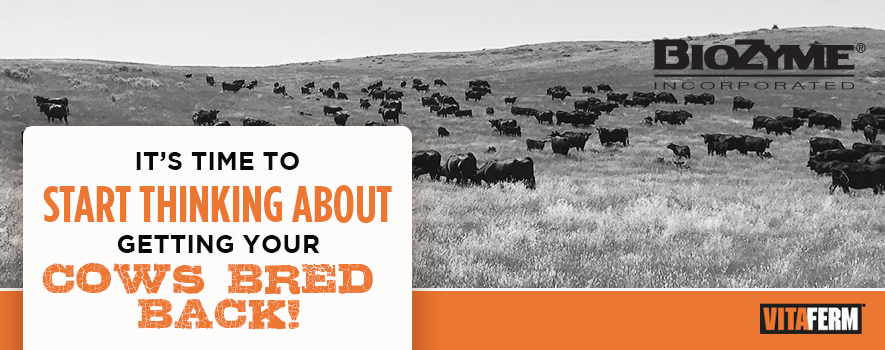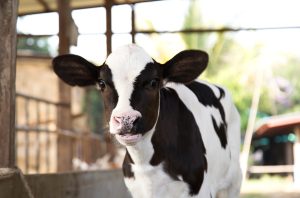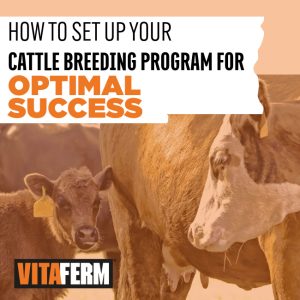Chris Cassady, Ph.D., Beef Technical Sales Manager

Spring is a time of renewal. Trees are budding, grass is greening up, and tractors are hitting the fields planting that next crop. If you are in the cattle business, you’re likely planning a future calf crop, too. It’s almost breeding time for those spring calvers, so you’re probably analyzing data, asking others about sire groups and deciding which bulls to use on your herd. Genetic selection is an important component; however, you also need to make sure your females are prepared nutritionally.
Reproduction is binary, resulting in a yes or no outcome at preg-check time. The challenge for producers is understanding every factor that influences a successful pregnancy. There must be adequate health and nutritional status, a reproductively sound bull covering the herd, quality semen, a skilled AI technician and so on. Since reproduction is not vital for life, it’s sensitive and is the first to fail if nutritional needs aren’t met. Basically, if a cow can’t sustain herself or her calf at side, mother nature decides she shouldn’t rebreed. The positive news is that health and nutrition play the biggest role in annual reproductive success, and are something the producer can influence.
To help ensure reproductive success, be precise with your nutritional program. Your cows need to work for you, but just like owning a business, your employees need the right tools to be successful. Understanding the needs of the individuals in the herd will pay dividends with your calf crop. Ideally, cows would be in a body condition score (BCS) 5 or 6, and a visual assessment of body condition has proven successful for decades. It can be hard to keep cattle in the right shape, as we are asking a lot of our cattle to repair their reproductive tract, support lactation for their calf and rebreed simultaneously. Not to mention those first timers are still growing, which adds another nutritional tax to their energy, protein, and vitamin and mineral demands. Consequently, thin cows happen to all of us, but don’t panic. Research has shown that cattle gaining weight heading into the breeding season have just as good of a chance of breeding successfully as their adequately fleshed herd mates. Getting the most out of your forages and supplementing with a quality vitamin and mineral program can give these females the nutritional boost they need to successfully breed.
Peak nutritional requirements often coincide with the spring green-up and immature, high quality lush forages. Keep in mind, the old saying, “the grass isn’t always greener on the other side” holds true in many cow-calf systems. A spring green-up after a severe drought may change the historic nutrient profile of your forages, as well as carry the potential for nitrate issues. One thing to consider in these lush pastures is elevated water content. Some of these “washy” grasses are only 20% dry matter, so animals can’t physically consume enough to meet their nutritional needs. Cows coming off a quality winter feeding program are now subject to a negative plane of nutrition. In several instances, this explains why cows in great shape may not breed as you’d expect. Knowing that your forages may carry a high-water content means getting the most out of that dry matter will be critical for your reproductive success. The take-home message: getting a forage test is a valuable method of knowing exactly what is available to your herd. Next, you will want to maximize the use of what is there.
AO-Biotics ® Amaferm® is a research-proven prebiotic that can help unlock the nutritional value of all types of forages. Amaferm goes beyond stimulating the growth of beneficial rumen bacteria and can also promote rumen fungal growth and enzymatic activity. This results in an increase in fiber digestibility and volatile fatty acid (VFA) production by 17% and 16%, respectively. As such, more energy becomes available to your cows, leading to more performance. BioZyme products like VitaFerm® Concept•Aid® offer premium vitamin and mineral supplementation that delivers Amaferm to your herd daily. Additionally, Concept•Aid contains organic zinc, copper and manganese and high levels of vitamin E for effective, easy breeding.
Concept•Aid comes in multiple formulas for various management scenarios. To discover the formula that would work best for your operation, visit the Concept•Aid Navigator.
Turning out that newly purchased herd bull or trying a new upcoming AI sire are some of the most exciting times of the production year. It’s easy to envision next year’s calf crop through rose colored lenses, but don’t forget, reproductive success is sensitive to many variables. Control what you can (nutrition) and let the positive outcome take care of itself.


